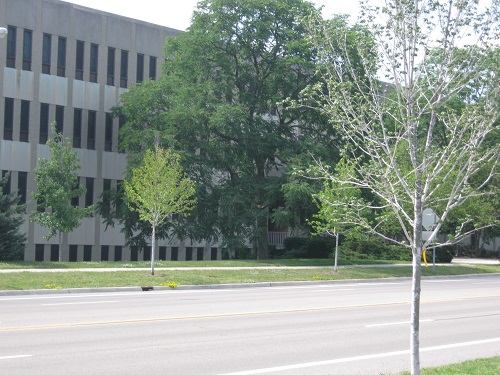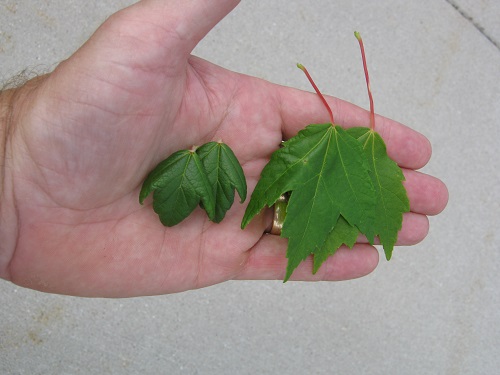The good news about being a landscape extension specialist is you get to comment on a variety of landscape tree problems. The bad news? You get to comment on a variety of landscape tree problems. In an average week I probably get 10-15 tree-related calls or e-mails from homeowners, landscapers, growers, extension educators, lawyers, newspapers, and on and on. Sometimes the problem is routine and obvious like tar spot on maples; “I have these spots that look like tar on my maple leaves…” Sometimes the problem looks routine and turns into something else entirely different like the Imprelis herbicide debacle. With the number if problems I respond to, invariable I sometimes end up shooting from the hip – and miss the mark.

Red maple with sparse canopy (right foreground). Maple in left-center of picture across the road was planted at the same time.
A few weeks back I noticed some red maples on campus that were struggling as they were starting to leaf out. There were planted about three years ago following a road-widening project. They are located on a tough site between a parking lot and a busy 4-lane road. My immediate diagnosis was they were weakened due to the aftereffects of last year’s sever heat and drought. I even included a photo of them in an article I did for our on-line extension news. Then this morning I happened to talk to a friend from our campus landscape services. “Boy, those maples sure took a beating from the drought last year”, I volunteered. My Landscape services friend replied, “Well, that and we hit them with Shortstop last year…” Uh oh, now the conversation was going in a different direction. Shortstop is a plant growth retardant, the active ingredient is paclobutrazol, which inhibits GA synthesis in plants and is being widely used by arborists to reduce the need for tree pruning. In this case it worked a little too well and the trees ended up being stunted.

Leaves of paclobutrazol-treat maple (left); untreated leaves on right.
In my defense, I was partly right. Under normal weather patterns paclobutrazol applied at the labeled rates (as was done here) would have reduced shoot growth and leaf growth but clearly the drought exaggerated the effect. So, another lesson learned (actually re-learned) never assume anything about trees until you talk to the people who actually take care of them.